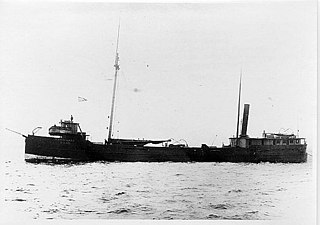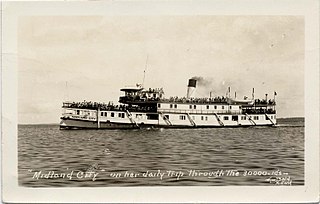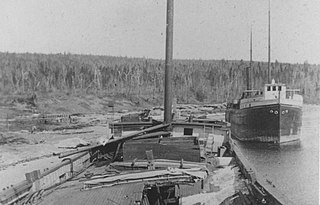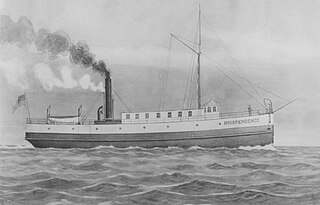History of name
Queen of the Lakes has been used as the name of three vessels that sailed on the Great Lakes, but none was the longest on the lakes at the time. The first was a three-masted Canadian schooner built in 1853 as Robert Taylor, measuring 133 feet (41 m). It was renamed Queen of the Lakes sometime before 1864. [2] She sank nine miles (14 km) off Sodus Point, New York on November 28, 1906. The second was a propeller-driven vessel launched in Cleveland, Ohio, on May 12, 1853, measuring 196 feet (60 m). She was lost to fire in port on June 17, 1869. [3] The third was a small side-wheel steamer built in Wyandotte, Michigan in 1872, measuring 108 feet (33 m). While anchored near South Manitou Island she caught fire and burned in 1898. The iron hull was later scrapped. [4]
The title has also been bestowed upon vessels that were especially liked [5] or those considered to be especially beautiful or richly appointed. Such was the case as late as 1949, at which time Noronic was so honored. [6] It has been applied to the United States Coast Guard cutter Mackinaw for its long and significant role in facilitating Great Lakes shipping and safety. [7] The most common use of the title, however, at least since the early 1940s, is to honor the largest vessel on the lakes. On April 20, 1841, the Detroit Free Press referred to the steamer Illinois as "Queen of the Waters", [8] but given that three vessels in that century were named Queen of the Lakes, its use as a title for the longest ship was not then common. The title is applied retroactively to vessels launched before this use of the title became popular. While some use gross tonnage, capacity, or length between perpendiculars as the criterion, the most commonly accepted standard is length overall (LOA). This article uses LOA as the standard.
Early Queens
The earliest vessels on the Great Lakes were human powered canoes and bateaux. Sources differ as to what vessel qualifies as the first real "ship" on the lakes. Many say it was Le Griffon, built by LaSalle through the winter and spring of 1678 and 1679, and launched in May of that year to sail the upper lakes (above Niagara). Reports of its size vary from 40 to 70 feet (12 to 21 m) long. Contemporary chroniclers called it both a bark and a brigantine. Le Griffon was soon lost. It was last seen on September 18, 1679 and was lost with all hands. Her final location is unknown. Those who consider Le Griffon to have been the first ship on the lakes—and hence, the first Queen—also consider her to have been the first lost. [9]
Other sources say the first ship was a smaller vessel built by LaSalle at Fort Frontenac beginning in September 1678, for the purpose of conveying supplies and material to Niagara. This vessel, which is called Frontenac in some reports, [10] is said to have been about 10 tons burthen, measuring from 35 to 45 feet (11 to 14 m) long. Expedition journalists called it a brigantine. It departed Fort Frontenac under La Motte's and Louis Hennepin's leadership on November 18, 1678, and arrived at the east bank of the Niagara River on December 6, 1679. Shortly thereafter, LaSalle and Tonty came with more supplies, and their vessel (carrying the anchor, rigging, and guns for Le Griffon) foundered in the surf less than thirty miles (48 km) from Niagara. Hennepin called this vessel a "great bark." One source says the loss occurred on January 8, 1679. Supplies and extra clothing were lost, but LaSalle and his men rescued material for the ship, dragged them to the mouth of the Niagara, rested a few days in an Indian village, and arrived at the settlement above the falls on January 20. [11] Some say the lost vessel was Frontenac. Historian Francis Parkman says that by 1677, there were already four vessels on Lake Ontario between 25 and 40 tons burthen. [12] He does not say if any of them were named. Tonty's journal indicates that the vessel he and LaSalle used was a 40-ton vessel, but he does not associate a name with it. [13]
Records of ship sizes on the lakes between 1678 and 1816 are rare. According to the Detroit Tribune , the vessels Gladwin, Lady Charlotte, Victory, and Boston were on the lakes in 1766 and Brunswick, Enterprise, and Charity were launched in 1767, 1769, and 1770, respectively, but no dimensions are given. [14] HMS Ontario, at 80 feet (24 m), was launched on Lake Ontario on May 10, 1780, and sank in a storm on October 31, that same year. [15] A history of Washington Island in Door County, Wisconsin notes that the schooner Washington, used to supply the fitting out of Fort Howard at the head of Green Bay in 1816, was the longest ship on the lakes at the time, but no details are given. [16]
A succession of Queens
On September 7, 1816, the steamer Frontenac was launched. She was fitted out as both a schooner and a side-wheel steamer and designed for both passenger and freight transport. At 170 feet (52 m) she laid claim to the honor of longest active vessel [lower-roman 1] on the lakes, though she saw service only on Lake Ontario. She was scrapped at Niagara in 1827, and the next verifiable Queen was not launched until 1830.
The chart below identifies the succession of vessels known to qualify as Queen of the Lakes from 1813 to the present. The succession of queens is not known to be continuous before David Dows. Those from Frontenac through City of Buffalo were side-wheel steamships, though Michigan, like Frontenac was dual fitted as an operational schooner. The heyday of the luxurious passenger steamers was waning even as some of them were launched. Mississippi, Plymouth Rock, and Western World were all out of service by 1859, and the Queens that had not already been lost by 1862 were rebuilt as barges or schooners or dismantled within a year. Nebraska was a propeller-driven steamer for freight and passenger use, but given what had happened to her predecessors, she was likely not so richly appointed. In 1904, Nebraska was refitted as a lumber carrier, after which time she resembled a classic bulk carrier. David Dows was a 5-masted schooner used primarily for transporting wheat. Susquehanna, Owego, and Chemung were propeller-driven package freighters. The whaleback Christopher Columbus was a celebrated passenger vessel. Onoko and all other vessels from Curry on were or are propeller-driven bulk carriers.
The steamship Quebec, launched in 1865, appears in lists of Great Lakes vessels. At 283 feet, she was longer than both Nebraska and David Dows, but her service was on the St. Lawrence River between Montreal and Quebec, not on the Great Lakes proper. She continued in service for many years and was dismantled in 1938.

A steamboat is a boat that is propelled primarily by steam power, typically driving propellers or paddlewheels. Steamboats sometimes use the prefix designation SS, S.S. or S/S or PS ; however, these designations are most often used for steamships.

Le Griffon was a sailing vessel built by French explorer and fur trader René-Robert Cavelier, Sieur de La Salle in the Niagara area of Canada in 1679.

Lake freighters, or lakers, are bulk carrier vessels that operate on the Great Lakes of North America. These vessels are traditionally called boats, although classified as ships.

The SS Christopher Columbus was an American excursion liner on the Great Lakes, in service between 1893 and 1933. She was the only whaleback ship ever built for passenger service. The ship was designed by Alexander McDougall, the developer and promoter of the whaleback design.

The history of commercial passenger shipping on the Great Lakes is long but uneven. It reached its zenith between the mid-19th century and the 1950s. As early as 1844, palace steamers carried passengers and cargo around the Great Lakes. By 1900, fleets of relatively luxurious passenger steamers plied the waters of the lower lakes, especially the major industrial centres of Chicago, Milwaukee, Detroit, Cleveland, Buffalo, and Toronto.

R. J. Hackett was a steamer built in 1869. When first launched, the ship's wide cross-section and long midships hold were unconventional, but the design's advantages in moving cargo through the inland lakes spawned many imitators. The Hackett is recognized as the first Great Lakes freighter, a vessel type that has dominated Great Lakes shipping for over 100 years. In 1905, the Hackett caught fire and sank on Whaleback Shoal in Green Bay, 9.5 miles (15.3 km) southeast of the Cedar River in Menominee County, Michigan. The wreck site was listed on the National Register of Historic Places in 1992.

SS Midland City was originally a Canadian side-wheel steamboat that provided passenger and cargo transportation on the Great Lakes from 1871 until 1955. Originally named Maud, then America, she underwent several extensive refits over her 84-year service, and saw several owners. The ship was intentionally run aground and burnt to the waterline in 1955 near the mouth of the Wye River in Midland Bay. The wreck is intact and visible above the water to this day, where it acts as a breakwater for the Wye Heritage Marina and local attraction.

The SS John Sherman, originally the USRC Sherman or USRC John Sherman was built for the United States Revenue Cutter Service in 1865 before being disposed of by the United States Government in 1872. It was a United States sidewheeler ship initially used as a Revenue Cutter on the Great Lakes of North America before being used for ferry service across Lake Michigan between the states of Michigan and Wisconsin. In 1874 the ship was chartered by Flint and Pere Marquette Railroad to become the first ship used by the company transporting freight and passengers.

SS Ira H. Owen was a steel-hulled American lake freighter in service between 1887 and 1905. One of the first steel lake freighters, she was built in 1887 in Cleveland, Ohio, by the Globe Iron Works Company, and was built for the Owen Line of Chicago, Illinois. Early in her career, Ira H. Owen carried iron ore from Escanaba, Michigan. In April 1898, Ira H. Owen was chartered by the Baltimore & Ohio Railroad. She was sold to the National Steamship Company of Chicago, on December 30, 1899, for whom she frequently carried coal and grain. Throughout her career, Ira H. Owen was involved in multiple accidents and incidents.


SS Choctaw was a steel-hulled American freighter in service between 1892 and 1915, on the Great Lakes of North America. She was a so-called monitor vessel, containing elements of traditional lake freighters and the whaleback ships designed by Alexander McDougall. Choctaw was built in 1892 by the Cleveland Shipbuilding Company in Cleveland, Ohio, and was originally owned by the Lake Superior Iron Company. She was sold to the Cleveland-Cliffs Iron Company in 1894 and spent the rest of her working life with it. On her regular route between Detroit, Escanaba, Marquette, and Cleveland, she carried iron ore downbound, and coal upbound.

SS Robert Wallace was a wooden-hulled American bulk freighter that served on the Great Lakes of North America from her construction in 1882 to her sinking in 1902 on Lake Superior near the town of Palmers, St. Louis County, Minnesota, United States. On November 17, 1902 shortly after leaving Superior, Wisconsin with a cargo of iron ore, Robert Wallace sprang a leak and sank. Her wreck was found in 2006, and on October 14, 2009, the wreck of Robert Wallace was listed in the National Register of Historic Places.

The George Spencer was a wooden lake freighter that sank on along with her schooner barge Amboy on Lake Superior, near Thomasville, Cook County, Minnesota in the Mataafa Storm of 1905. On April 14, 1994, the wrecks of the Spencer and the Amboy were listed on the National Register of Historic Places.

The Amboy was a wooden schooner barge that sank along with her towing steamer, the George Spencer on Lake Superior off the coast of Schroeder, Cook County, Minnesota in the United States. In 1994 the remains of the Amboy were added to the National Register of Historic Places.

The AmboyandGeorge SpencerShipwreck Site is an archeological shipwreck site which consists of the wrecks of the wooden bulk freighter George Spencer and the wooden schooner-barge Amboy. Both vessels were wrecked during the Mataafa Storm of 1905. In 1994 the site was added to the National Register of Historic Places.

The Independence was a propeller-driven steamboat that was the first steam-driven vessel to run on Lake Superior in October 1845, initiating the era of steam navigation on that lake. During her career, she saw service shipping passengers and supplies to the mining settlements along the south shores of the lake and often returning with copper ore or was commissioned to carry other goods. Her eight-year career on Lake Superior ended when her boilers exploded, killing several aboard, and ultimately sending the steamboat to the bottom in pieces.



















